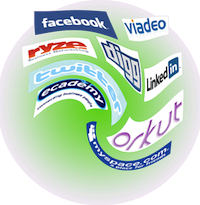By Christopher Rollyson  As I predicted in Web 2.0 Adoption Curve, 2009-2015, a media backlash against social networks is beginning because most people do not know how to use the networks effectively nor how to integrate their activity on social networks with their other activities. The use of social networks is in its infancy and is easy to criticize. As I predicted in Web 2.0 Adoption Curve, 2009-2015, a media backlash against social networks is beginning because most people do not know how to use the networks effectively nor how to integrate their activity on social networks with their other activities. The use of social networks is in its infancy and is easy to criticize.
Last week, I took the New York Times’ Facebook Exodus to task as an exceptionally lame example, and here I’ll offer a briefer treatment of a Wall Street Journal article, How Facebook Can Ruin Relationships. Unfortunately, but very predictably, the journalists and editors that are responsible for these articles are not terribly knowledgeable about social networks. Take this into account when reading.
This backlash will discredit social networks in the short term, and you can use this to your advantage by continuing to use them in your business while others are napping. Social networks will remake society because they change the economics of communication and relationships. Those who use them will create a significant advantage for themselves.
By Christopher Rollyson Spats on the Road of Transformation—Backlash Right on Schedule
 As the Web 2.0 Adoption Curve, 2009-2015 predicts, there will be a significant backlash against social networks during 2009-2010 because the market’s perceived value of social networks is much higher than its skill with the tools, and this will result in inflated expectations and disappointments. Most decision makers are distracted by social networks’ novelty and features, and they overlook the obvious, that social networks offer a quantum leap in productivity for developing and managing relationships. As the Web 2.0 Adoption Curve, 2009-2015 predicts, there will be a significant backlash against social networks during 2009-2010 because the market’s perceived value of social networks is much higher than its skill with the tools, and this will result in inflated expectations and disappointments. Most decision makers are distracted by social networks’ novelty and features, and they overlook the obvious, that social networks offer a quantum leap in productivity for developing and managing relationships.
The MSM (mainstream media) have at best an ambivalent relationship with social networks because the latter weaken their monopoly on influence and mass communications. Consequently, they face a double barrier in understanding social networks’ value proposition: 1) like the rest of the market, they require time to understand how they can best use social networks in meaningful ways and 2) since they perceive social networks as challengers, they are too ready to be dismissive. Executives will be well served to keep this in mind lest they be influenced into rejecting social networks’ promise too hastily.
To illustrate the point, I will comment on Facebook Exodus from the New York Times as an example of self-indulgent journalism that will add to the backlash. Expect a wave of such press in the coming months.
By Christopher Rollyson  I’m pleased to give you an update on the panel I’m running at PanIIT on October 9, 2009, in Chicago. We will have pioneers from Alcatel-Lucent, Allstate and Experian sharing how they are using social networking to innovate inside and outside the enterprise. In addition, two social networking platform experts will discuss emerging trends in LinkedIn, Facebook, Twitter and YouTube and how individuals and companies can use them to get ahead. But you have to read beneath the fold* to learn the names and the agenda! I’m pleased to give you an update on the panel I’m running at PanIIT on October 9, 2009, in Chicago. We will have pioneers from Alcatel-Lucent, Allstate and Experian sharing how they are using social networking to innovate inside and outside the enterprise. In addition, two social networking platform experts will discuss emerging trends in LinkedIn, Facebook, Twitter and YouTube and how individuals and companies can use them to get ahead. But you have to read beneath the fold* to learn the names and the agenda!
By Christopher Rollyson Social Networks and the Relationship Life Cycle: Myths and Realities shows how to use social networks to lower the costs of the four stages of developing relationships.
Contradictions Abound—What Seems New Is Ancient—Sorting through the Clutter to Create Value
 Digital social networks are transforming every field of human endeavor, from society and romance to politics and business. This is happening because they change the economics of how people discover, develop and maintain relationships. Although some will argue this point, we humans share with other animals the propensity to take more of something desirable when given the chance, and social networks enable us to have more relationships. Digital social networks are transforming every field of human endeavor, from society and romance to politics and business. This is happening because they change the economics of how people discover, develop and maintain relationships. Although some will argue this point, we humans share with other animals the propensity to take more of something desirable when given the chance, and social networks enable us to have more relationships.
However, as I predicted in the Web 2.0 Adoption Curve, 2009-2015, there will be a significant backlash against social networks during 2009-2010 because the market’s perceived value of social networks is much higher than its skill with the tools. This will result in inflated expectations and ensuing disappointments. Most executives are distracted by social networks’ strangeness and features, and they miss the obvious, that social networks offer a quantum leap in productivity for developing and managing relationships. Much of the market will reject social networks as a fad and will sit on the sidelines during the Failure & Disappointment part of the adoption curve. However, people and companies that understand the real proposition will develop a rare competitive advantage while competitors are snoozing.
By Christopher Rollyson 
Enterprise Social Networking Panel to Emphasise Innovation, Risk Mitigation previews new opportunity and risk mitigation theme at SNC London. I will be leading a new panel at the Social Networking Conference, “Enterprise Social Networking for Innovation: Case Studies, Approaches and Tools” in London, September 24-25. I’ll be grilling executives from healthcare, financial services, telecoms and consumer products about their challenges and lessons learned. Read on for the full description.
By Christopher Rollyson  Clients and friends constantly ask whether quality or quantity is more important in developing social networks (as if they think there is an absolute answer ,^). We all understand generally that there is a trade-off between quality and quantity. Social network activity can be time-consuming, and it is difficult to understand the return on investment. Here I’ll offer some reflections on how to think about your network strategy for Twitter followers, your LinkedIn network or your group of Facebook friends. Clients and friends constantly ask whether quality or quantity is more important in developing social networks (as if they think there is an absolute answer ,^). We all understand generally that there is a trade-off between quality and quantity. Social network activity can be time-consuming, and it is difficult to understand the return on investment. Here I’ll offer some reflections on how to think about your network strategy for Twitter followers, your LinkedIn network or your group of Facebook friends.
By Christopher Rollyson  When I suggest using Facebook for business to executives, I usually get a raised eyebrow or an incredulous stare. However their attitude quickly changes when I ask them to reflect on the last three business lunches they had with prospects and what they talked about. When I suggest using Facebook for business to executives, I usually get a raised eyebrow or an incredulous stare. However their attitude quickly changes when I ask them to reflect on the last three business lunches they had with prospects and what they talked about.
Business meetings often include sports, culture, family and light politics/news… things that people share on Facebook.
Continue reading LinkedIn Brief3 How Do You Use Facebook to Accelerate LinkedIn Results?
By Christopher Rollyson  I’m excited to announce that I’ll be leading a panel at the PanIIT global conference on October 9, 2009 in Chicago, where we’ll discuss how enterprise visionaries are using social networks to innovate in their business processes. We will be speaking alongside such global luminaries as President Bill Clinton, Caterpillar CEO James W. Owens and Obama Administration CTO Aneesh Chopra. Here is a description of our session: I’m excited to announce that I’ll be leading a panel at the PanIIT global conference on October 9, 2009 in Chicago, where we’ll discuss how enterprise visionaries are using social networks to innovate in their business processes. We will be speaking alongside such global luminaries as President Bill Clinton, Caterpillar CEO James W. Owens and Obama Administration CTO Aneesh Chopra. Here is a description of our session:
By Christopher Rollyson  More is better, right? Not necessarily. To get on the right track with LinkedIn Recommendations, don’t try to manage the content (what someone writes on your behalf), but do try to manage the process (try to steer the person to a situation about which they can write authentically). More is better, right? Not necessarily. To get on the right track with LinkedIn Recommendations, don’t try to manage the content (what someone writes on your behalf), but do try to manage the process (try to steer the person to a situation about which they can write authentically).
To do this effectively, keep three things in mind:
By Christopher Rollyson  The ultimate answer to this question will depend on the kind of business you are in, your personal style and the expectations of the most important business people in your life. The ultimate answer to this question will depend on the kind of business you are in, your personal style and the expectations of the most important business people in your life.
Here are some questions to help you get to the answer:
- Are you in a transaction-oriented business in which product and speed are most important? (need to be in the right place at the right time)
- Or, does your business involve long sales cycles and highly customized products or services? In other words, is yours a relationship business?
Continue reading LinkedIn Brief1 How Many LinkedIn Connections Do You Need to Move the Ball?
|
|
 As I predicted in Web 2.0 Adoption Curve, 2009-2015, a media backlash against social networks is beginning because most people do not know how to use the networks effectively nor how to integrate their activity on social networks with their other activities. The use of social networks is in its infancy and is easy to criticize.
As I predicted in Web 2.0 Adoption Curve, 2009-2015, a media backlash against social networks is beginning because most people do not know how to use the networks effectively nor how to integrate their activity on social networks with their other activities. The use of social networks is in its infancy and is easy to criticize.




